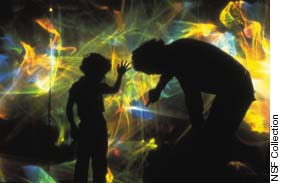
A Vision for a National Role
Often in the past, the Board focused more on its NSF oversight responsibilities than on its national policy mandate. But in the 1990s, as the Board passed a mature forty years of age, ecologist and former Board member Shirley S. Malcom of the American Association for the Advancement of Science (AAAS), says the Board became more of a "National Science Board."
 Stanford University chemist Richard N. Zare, who joined the Board in 1992 and became its chair in 1996,
championed a strong vision for how the Board could exercise its legal mandate to "advise the President
and Congress, whether on their request or on its own initiative" regarding policy matters related to
science and engineering, and on education in these fields.
Stanford University chemist Richard N. Zare, who joined the Board in 1992 and became its chair in 1996,
championed a strong vision for how the Board could exercise its legal mandate to "advise the President
and Congress, whether on their request or on its own initiative" regarding policy matters related to
science and engineering, and on education in these fields.
The group is "a sounding board," he says, "a forum to bring together visions for the future from different federal agencies and stakeholders." The Board should not set a particular President's science policy or respond to near-term exigencies; these duties belong to the President's Science Advisor and to the President's Committee of Advisors on Science and Technology (PCAST). But the National Science Board is uniquely positioned to "engage in long-term planning" of scientific needs and strategies. He notes that members' terms are six years, whereas the President who appoints them serves four. What's more, the Board Chair is elected by the members, not chosen by the President. "This makes [the Board] as nonpolitical a policy group as it can be," while still carrying the authority of a federal body-the only governmental body with a legal mandate to advise the President and Congress on the health of science, engineering, and related education across all fields.
"Vannevar Bush's vision was that the Board would do it all," Zare notes. "But there was not a big National Institutes of Health in 1945; there was no White House Science Advisor. I'm not trying to roll back time. I'm pointing out there's a need to do something now, in addition to what the White House does."
As Chair, Zare waded into the key national science policy question of the day: how the government should set federal research priorities in light of inevitable limits on spending and the growing expense and scale of basic research. Former Board members and chairmen James Duderstadt and Frank Rhodes had initiated the Board's consideration of the issue in the early 1990s. Now Zare and other Board members went a step further and met with past presidential Science Advisors and research directors from other federal agencies to discuss their basic research programs and needs, and how the Board could be useful to them. In 1997, the Board issued its report. Government Funding of Scientific Research argued that given the wholly new, global context for research, and the dramatic breakthroughs in so many fields at once, "one must also ask what is the appropriate scale of the investment to meet the needs of the greatest economic power in the world."
